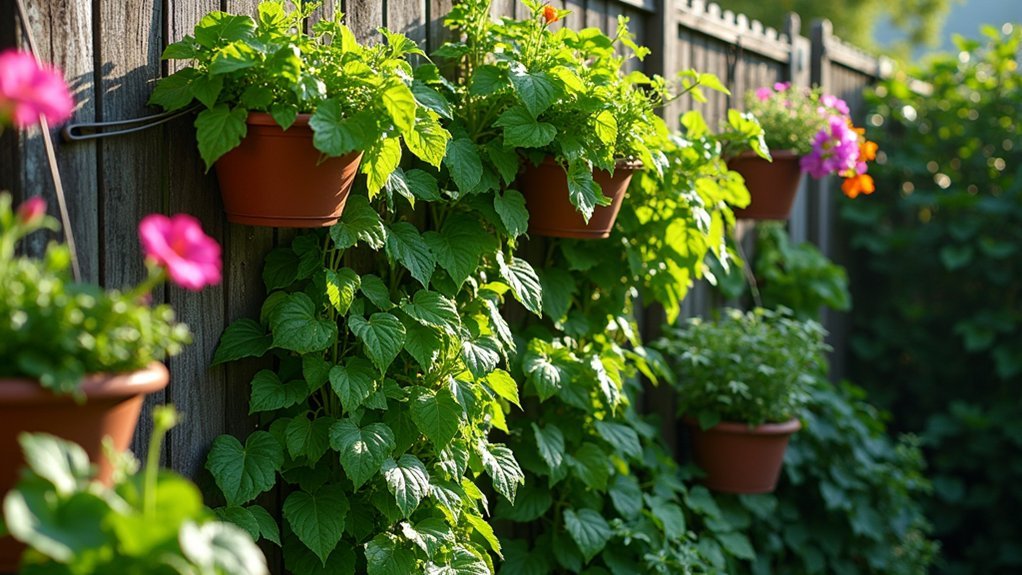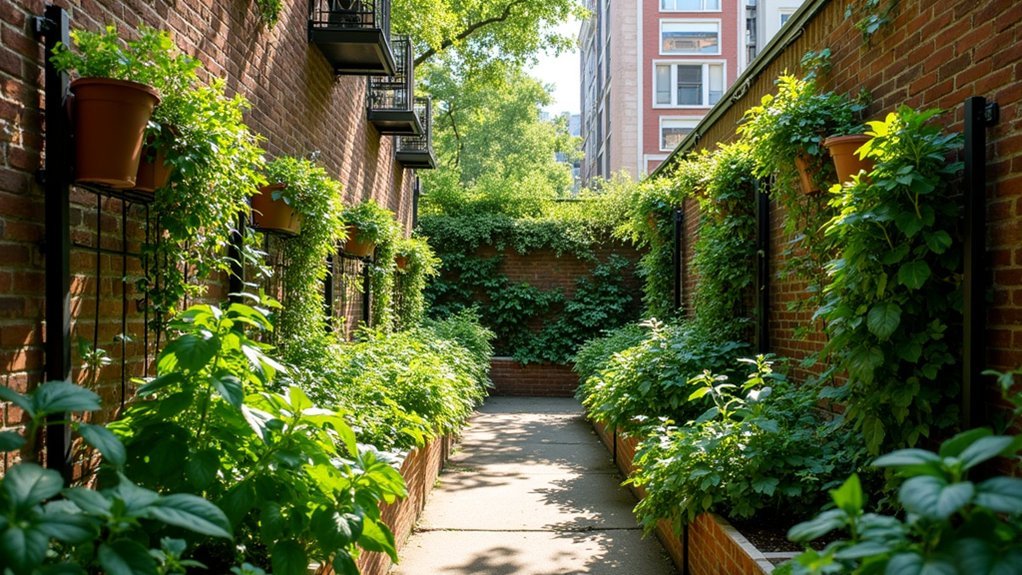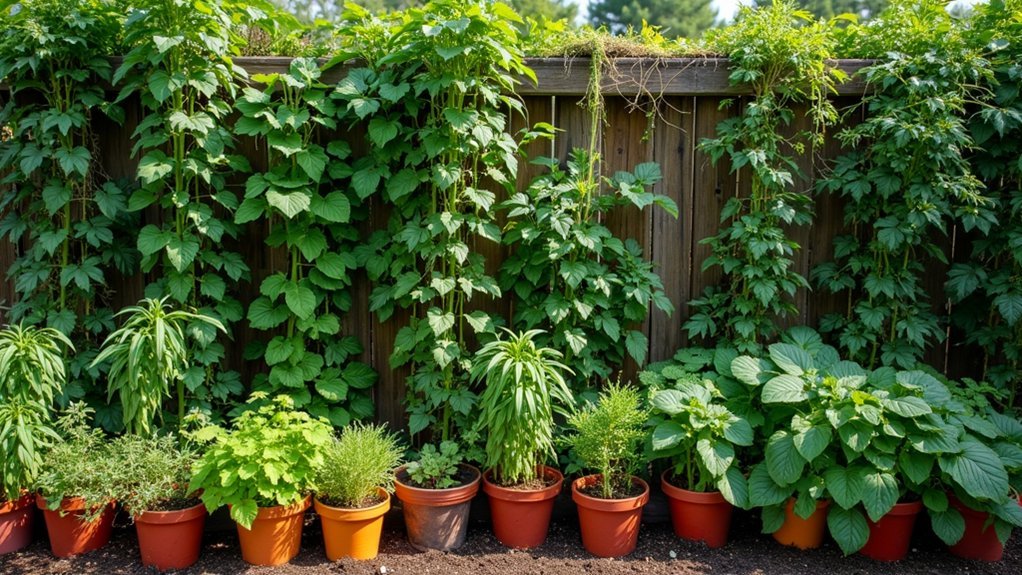Space-efficient edible fencing transforms your property boundaries into productive growing areas while maintaining privacy and security. You’ll maximize vertical space, reduce garden clutter, and create a beautiful living barrier that produces food year-round. These multifunctional borders support biodiversity, deter pests naturally, and greatly increase your harvest potential. Whether you choose berry brambles, grape vines, or espaliered fruit trees, you’ll enjoy fresh harvests with minimal maintenance while making every inch of your garden work harder.
Maximize Limited Space With Vertical Edible Fencing

When space is at a premium in your garden, vertical edible fencing offers an ingenious solution to maximize growing potential. By growing upward instead of outward, you’ll effectively multiply your usable planting zones without expanding your garden’s footprint.
Vertical growing transforms boundaries into bountiful food production zones, perfect for space-limited gardens.
Install trellises or mesh fencing to support sprawling crops like cucumbers, beans, and peas that would otherwise consume valuable ground space. You’ll transform ordinary boundaries into productive growing areas that serve dual purposes—defining your garden while producing food.
This approach considerably reduces garden clutter, freeing up ground space for additional crops or pathways. Your vertical growing space can accommodate a variety of vegetables like tomatoes and squash that thrive with proper support systems.
Your vertical structures will create cleaner growing conditions by elevating plants off soil where pests and diseases often lurk. You’ll enjoy better air circulation around plants, leading to healthier growth and reduced fungal issues.
Cost-Effective Alternatives to Traditional Barriers
Traditional fencing often demands a significant investment, but creating boundaries in your garden doesn’t need to drain your wallet.
Consider using bamboo or natural reed mats for an affordable tropical aesthetic, or repurpose pallet wood into privacy walls at minimal cost.
For the budget-conscious DIY enthusiast, treated pine offers durability without breaking the bank.
You’ll save substantially by installing the fence yourself and renting tools rather than purchasing them.
Chain link or hog wire can provide structure while climbing edibles like blackberries or grapes transform functional barriers into productive ones.
Don’t overlook the long-term benefits of edible fences—they not only reduce initial costs but also yield food, support wildlife, and often require less maintenance than conventional options.
With recycled materials and community help, your boundary can be both economical and sustainable.
Fast-growing climbing vines create natural privacy while adding beauty to ivy-covered trellis installations, perfect for small yards with close neighbors.
Sustainable Living Boundaries for Urban Gardens

You’ll transform your garden’s perimeter into a productive growing area with vertical harvests that utilize walls, trellises, and fences for climbing edibles.
These space-maximizing techniques allow you to grow food upward rather than outward, perfect for confined urban environments where every square foot counts.
Multifunctional border solutions, like espaliered fruit trees or berry-producing hedges, serve as beautiful living boundaries while providing seasonal harvests and supporting local biodiversity. Living fences significantly help reduce carbon footprint by bringing food production closer to your home.
Vertical Harvests Maximize Space
Urban gardens transform dramatically once vertical growing techniques are implemented, turning limited square footage into abundant food-producing zones.
You’ll gain significant growing capacity by training plants upward rather than outward, using wall-mounted trellises and fence structures.
Plants like pole beans, peas, and cherry tomatoes thrive in vertical systems, while smaller squash varieties and eggplants can be trained to climb with proper support.
This approach keeps fruits off the ground, reducing rot and disease while improving airflow around your plants.
Your vertical edible fence serves multiple functions: creating privacy boundaries, increasing productivity per square foot, and enhancing biodiversity by attracting beneficial insects.
Choose durable materials for your trellis designs—A-frames or teepees work well for long rows of climbers, ensuring your living fence remains stable under the weight of a bountiful harvest.
Climbing green beans are excellent fence plants that require 6-8 hours of direct sunlight daily to produce abundant harvests.
Multifunctional Border Solutions
While vertical systems maximize growing capacity upward, effective garden boundaries must also work horizontally to create multifunctional spaces that serve both practical and aesthetic purposes. You’ll transform ordinary barriers into productive zones by planting edible fences using blueberries or rosemary, which replace non-productive structures while defining your garden’s perimeter. Implementing succession planting techniques allows these living boundaries to remain productive throughout the growing season.
| Border Solution | Emotional Benefit |
|---|---|
| Rainbow chard edges | Joy from vibrant colors year-round |
| Herbal tea boundaries | Serenity during harvest rituals |
| Bean pole privacy screens | Pride in self-sufficiency |
| Pollinator-friendly borders | Connection to ecological cycles |
| Shared community edges | Belonging through collaboration |
These multifunctional borders don’t just maximize yields through intercropping and modular design—they create microclimate benefits, sequester carbon, and foster biodiversity while turning formerly wasted space into productive, beautiful assets.
Design Strategies for Multi-Functional Edible Borders
Creating effective edible borders requires thoughtful planning that balances both form and function in your limited garden space.
Implement layered planting techniques to maximize both vertical and horizontal dimensions, combining tall perennials with lower-growing herbs and vegetables. Utilizing fewer plant varieties creates visual order and simplifies maintenance while still maintaining aesthetic appeal.
Layering tall perennials with ground-hugging edibles transforms limited space into a productive three-dimensional garden ecosystem.
Select plants that serve dual purposes—beautifying your landscape while providing food. Include native edibles that thrive with minimal maintenance and drought-tolerant varieties for resilience.
Arrange plants to create colorful, textural patterns that maintain interest across seasons by incorporating evergreen elements.
Don’t overlook fragrant herbs like rosemary and thyme, which offer both culinary value and pleasing aromas.
Design your borders to attract pollinators while creating beneficial microclimates. For maximum impact, establish focal points with statement plants and use climbing varieties on fences to transform vertical surfaces into productive growing areas.
Productivity Tips for Small-Scale Fence Gardening

Maximizing productivity in small-scale fence gardens requires strategic planning and clever space utilization.
Start by implementing vertical gardening techniques with trellises and hanging planters to make the most of your limited space. Consider attaching vertical planter boxes directly to your fence for herbs and compact vegetables.
Boost efficiency with self-watering systems and timer-based irrigation that reduce maintenance time while guaranteeing plants receive consistent moisture.
Try high-density planting methods, placing plants close together along the fence line to increase yield per square foot.
Establish a layered approach, with taller plants against the fence and shorter varieties in front. For fencing material, consider using pressure-treated posts which offer durability and longevity for your garden structure.
Dedicate a few minutes daily to garden maintenance rather than longer, less frequent sessions.
Remember to rotate crops seasonally to maintain soil health and guarantee continuous harvests throughout the year.
Low-Maintenance Edible Fence Options for Busy Gardeners
You’ll find that edible fences can produce plentiful harvests with minimal effort through strategic plant selection like elderberry, hazelnut, and feijoa.
Self-sustaining fence designs incorporate drought-tolerant options such as quince and strawberry guava that thrive even when neglected. Natal plum makes an excellent addition with its dense evergreen leaves that provide year-round privacy while requiring minimal maintenance.
Training edible vines like kiwi and grapes along sturdy structures creates productive barriers that require little more than annual pruning while maximizing your limited gardening time.
Harvest With Less Effort
Busy gardeners can transform their property boundaries into productive food sources without committing to hours of weekly maintenance. The right plant selections offer privacy, beauty, and food with minimal effort.
| Plant Option | Maintenance Level | Key Benefit | Harvest Season |
|---|---|---|---|
| Hazelnut | Low | Dense privacy hedge | Fall |
| Quince Trees | Low | Drought tolerant | Late fall |
| Elderberry | Minimal | Easy-to-manage growth | Summer |
| Currant Bushes | Low | Shade-tolerant | Early summer |
Options like black raspberries and passion fruit vines can be trained along existing structures, maximizing your space efficiency. For even less work, consider rugosa roses that provide edible hips while requiring only occasional pruning. Pomegranates form dense hedges with thorns that offer excellent security while producing delicious fruits in zones 7-10. These plants support local biodiversity while producing food—a win-win for busy homeowners seeking functional landscapes.
Self-Sustaining Fence Designs
Creating self-sustaining fence designs requires thoughtful integration of structure and plant selection. Start with durable materials like galvanized steel fencing or cedar posts that provide long-term support for your edible plants while minimizing maintenance.
Incorporate polyculture plantings by combining fruit trees, berry varieties, and vines with staggered harvest times. This diversity not only provides continuous yields but also creates natural pest resistance. You can achieve a productive fence with nearly 30 different berry varieties similar to forest garden approaches.
Consider training grapevines or kiwis along cattle panels, which offer excellent structural support while maximizing vertical growing space.
Built-in irrigation systems dramatically reduce your workload, while companion planting naturally deters pests. Implement hügelkultur beds alongside your fence line to improve soil fertility and water retention.
These integrated approaches create a self-perpetuating ecosystem where beneficial insects thrive, pollination increases, and your edible fence becomes more productive each season.
Frequently Asked Questions
How Do I Prevent Animals From Eating My Edible Fence?
Use metal fencing buried 12 inches underground, install netting around your edible plants, apply peppermint oil as a repellent, and choose less palatable plants when designing your fence. You’ll keep hungry critters away!
Can Edible Fences Withstand Extreme Weather Conditions?
Yes, your edible fence can withstand extreme weather when you select resilient species, use composite materials, and implement structural adaptations like gabion cages and sloped beds. Many perennials regrow quickly after damage from storms.
Are There Toxic Edible Plants to Avoid Near Children?
Yes, avoid planting oleander, azalea, morning glory, castor oil plant, and deadly nightshade near children. These plants contain toxins that can cause serious symptoms including nausea, vomiting, irregular heartbeat, and even death if ingested.
How Long Before an Edible Fence Provides Effective Privacy?
You’ll see varying timelines for privacy from your edible fence. Fast-growing varieties like raspberries provide screening in 1-2 seasons, while fruit trees may take 3-5 years to form an effective privacy barrier.
What Edible Plants Work Best in Shady Fence Locations?
In shady fence locations, you’ll find that mint, Swiss chard, hostas, cucamelons, and currants thrive best. Don’t forget garlic, peas, and sweet potato vines – they’ll provide food while adapting to lower light conditions.
In Summary
Space-efficient edible fences aren’t just barriers—they’re productive investments in your garden’s future. You’ll save money, space, and time while enjoying fresh harvests from your boundaries. Whether you’re working with a tiny urban plot or simply want more from your landscape, these living borders transform unused vertical space into food-producing assets. Start small, expand gradually, and you’ll soon reap the rewards of your edible perimeter.





Leave a Reply